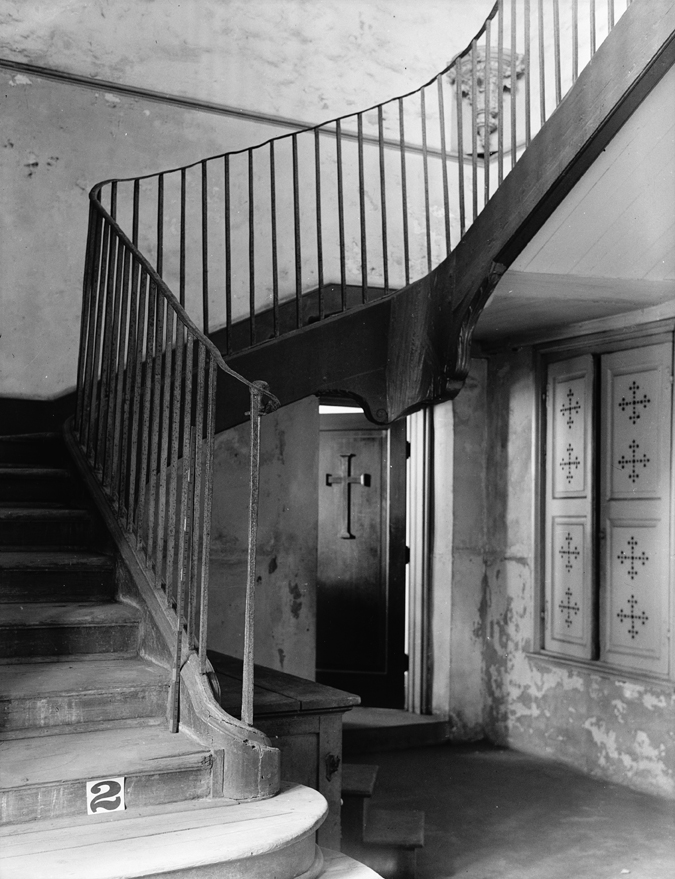Richard Koch
Louisiana architect and preservationist Richard Koch worked with the Historic American Buildings Survey (HABS) in the state during the Great Depression.

Courtesy of Library of Congress Prints and Photographs Division
Ursuline Convent, main stairway. Koch, Richard (Photographer)
A fervent preservationist and talented architect, Richard Koch is perhaps best known for his work with the Historic American Buildings Survey (HABS) during the Great Depression. As district officer, Koch led a team of architects in their efforts to document endangered historic buildings in Louisiana with drawings, plans, and photographs. A leader in the establishment of the Vieux Carre Commission and the Arts and Crafts Club of New Orleans, Koch was also a dominant figure in the civic and cultural life of New Orleans, particularly during the 1920s and 1930s. His work promoted scholarly research, cultural enhancement, and civic development in ways entirely unforeseen at the time.
Early Life and Career
Born June 9, 1889, in New Orleans, Koch was the son of Anna Frotscher and Julius Koch, a German immigrant. After earning his architectural degree from Tulane University in 1910, Koch continued his studies in Paris, France. He then worked in several northeastern architectural offices before returning to in 1916. On his return, Koch formed a partnership with Charles Armstrong, with whom he had studied in Paris. The Armstrong Koch firm pioneered the restoration and adaptive reuse of historic buildings in the state. The firm reclaimed and restored many buildings, including Shadows-on-the-Teche in 1922, and Oak Alley, the legendary plantation house in Vacherie, in 1926. That same year the firm also restored the Victor David House at 620 St. Peter Street in New Orleans. Next door, Koch designed a new building for Le Petit Theatre du Vieux Carre in a traditional style that blended seamlessly with its surroundings. A good draftsman and watercolorist, Koch became an accomplished photographer of buildings in the 1930s, before such skills were commonplace. With his large-format Hasselblad camera, he recorded many irreplaceable landmarks, often just ahead of the wrecking ball. His firm’s restorations helped increase awareness of the need for historic preservation and spark a renaissance of cultural activity in New Orleans’s French Quarter.
Historic American Buildings Survey
In 1934, Koch became leader of HABS in Louisiana. The first federal preservation program, HABS documented America’s architectural heritage on a state-by-state basis. Koch’s encyclopedic knowledge of Louisiana’s historic buildings and his reputation for exacting standards made him an ideal choice to lead the survey. Soon after his appointment, he assembled a talented team of nineteen architects and draftsmen. Augmenting Koch’s photographic contribution were two well-known preWorld War II architectural photographers,Robert E. Tebbs and Frances Benjamin Johnston. During the next seven years, Koch and his team traveled the back roads of rural Louisiana and the picturesque streets of New Orleans, documenting the state’s most valuable and endangered buildings.
In what may be the most comprehensive record ever compiled of Louisiana’s historical architecture, Koch created a wish list of 150 structures that he deemed worthy of documenting, based on age, rareness of type, and vulnerability to demolition or decay. Documentation of each building consisted of exact, often beautiful, measured drawings; photographs (many taken by Koch); and written information. The final portfolios were sent to Washington, DC, and placed in the Prints and Documents Division of the Library of Congress, where they are available for public use. Copies are also available in various repositories around the state. Under his leadership, the team managed to document sixty-three buildings before the outbreak of World War IIcurtailed HABS activities.
Shortly after Koch began his work with HABS, Charles Armstrong ended their architectural partnership. Samuel Wilson, Jr., who had documented the Beauregard-Keyes House, the Cabildo, the Ursuline Convent, and other buildings for HABS, joined Koch’s firm in 1935. Together, Koch and Wilson worked on Works Progress Administration projects in New Orleans’s City Park, such as the golf house, pigeonnieres, shelters, bridges, gardens, and stadium. Wilson was made partner in 1955 and the two undertook many restorations, including the Pitot House, the Pontalba Buildings, Gallier House, San Francisco Plantation, and St. Patrick Church in New Orleans. Working together until Koch’s death on September 20, 1971, the two also executed a number of new buildings.
Koch’s Legacy
As a pioneer preservationist, Koch’s seminal work and enthusiastic promotion helped ignite statewide interest in preserving, displaying, and promoting Louisiana’s unrivalled architectural heritage. In New Orleans, his firm’s restoration of French Quarter buildings helped develop many now-popular tourist destinations. The Beauregard Keyes House, Madam John’s Legacy, the Hermann-Grima House, Lafitte’s Blacksmith Shop, the Girod House (now known as The Napoleon House) and the Villa Meilleur (now known as The African-American History Museum) are all examples.
Though Koch’s career coincided with modernism’s break with traditional forms, only one of his buildings suggested the influence of the popular International Style: the tuberculosis unit for Lafayette Charity Hospital in Lafayette. Of all house styles, Koch stated that his favorite was the Louisiana colonial style of Pitot House on Bayou St. John in New Orleans. Essentially, Koch remained an eclectic traditionalist, never married to any one stylistic convention. His frequent collaborations with Armstrong, Wilson, and others enhanced and reflected his eclecticism.
Much contemporary scholarly research is based on the measured drawings created through Koch’s survey work. Reconstructions, such as those of the cupola of the Cabildo after the 1986 fire, and the rare double flues of the Rene Beauregard House chimney at the Chalmette Battle Ground, used survey drawings to recreate the damaged buildings exactly. As a preservationist, an architect, and a documentarian, Koch played a central role, perhaps the central role, in Louisiana’s architectural history. Many of his records and papers are in the Southeastern Architectural Archive at Tulane University.
